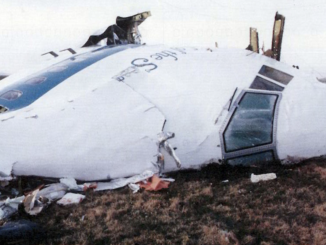Last time on Mystery Album I forgot to tell Puffins that the first Swedish monarch, King Gustav VI Adolph, to be interred at Kungliga Begravningsplatsen and away from Riddarholmen Church (apart from the wayward Christina) was Lord Mountbatten of Burma’s brother in law. What? You already knew? Excuse me. Therefore, regular readers will also already know that the wife in question was Mountbatten’s older sister, Louise.
Her eldest brother, George Marquis of Milford Haven’s collection of pornography was so comprehensive it gained academic significance. A friend tells me the vital exhibits were donated to the Victoria and Abert Museum’s ‘Private Case’ with any rejected items being passed on to the Kinsey Institute For Sexual Health Research. Apparently, his French postcards with moveable parts particularly caught the scholarly eye.
The youngest Mountbatten sibling was Alice, who married Prince Andrew of Greece and one of whose subsequent offspring was our very own Prince Philip, the Duke of Edinburgh.
Now that we’ve got that out of the way, our posh mystery family of posh travelling photographers have moved on from Sweden and, as your humble reviewer of old photographs turns the page to reveal some more near hundred-year-old sepia prints, he is confronted with the unmistakable southern entrance to Helsinki Central Station which lies 250 miles across the Baltic from Stockholm.
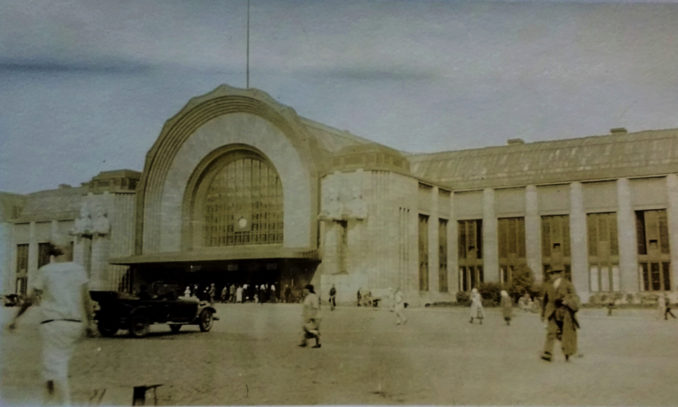
© Always Worth Saying, Going Postal 2021
In my day, halfway between then and now, the Viking and Silja Lines operated car ferries to Finland, all of them overnight and some of them usefully into Helsinki rather than to Turku, a hundred miles away. The Viking vessels docked at Katajanokka and the Silja at Etelasatama. Katajanokka is only about a mile from Central Station and Etelasatama (always known as Satama) is even closer.
Katajanokka is a small island that connects to Helsinki proper by a short bridge. The Viking docks are still on the southern shore while a quay for the Finnish ice breaker fleet sits at the northern. As with Holmen at Copenhagen, there used to be a naval base guarding the approaches to Helsinki and this was it.
If you think the impressive building opposite the northern quay, now the Finnish Foreign Ministry, is like something from the Tsar’s St Petersburg you wouldn’t be far wrong as it was originally built by the Russians, in imperial days, as a base for their Baltic fleet. From here, the approaches to nearby St Petersburg, only 160 miles to the east, were protected. In Russia, a 160 mile trip along the Gulf of Finland counts as ‘nearby’. A pirouette on the Street View link will reveal the ice breakers.
We shall assume our mystery family docked at Satama, which seems the more obvious choice, and strolled ‘ports of call’ style for the 1,000 yards or so to Central Station through Esplanadi Park and via the main shopping street of Keskuskatu before taking a photograph of the southern entrance of the station at the corner of Keskuskatu and Kaivokatu.
If you think all these names sound Russian you’re wrong. Finnish is not like Russian, it is like Hungarian, as if tribes from the Urals split, some settling west in Finland and others southwest on the Hungarian plain. If a Hungarian contradicts this, he is mistaken and a snob wanting to be descended from Athenians rather than from the ‘country people’ of the Urals.[1]
The view is recognisable today but very cluttered with an endless calm sea of cobble sets having been replaced with tarmac, kerbs, pavement, railings, road signs and signals, bus shelters and entrances to an underpass that connects the shopping streets to the station.
The actual building behind it all impresses. Designed by architect Eliel Saarinen (1873-1950), his plan was completed by 1909, the building completed in 1914 but, as war interrupted, not officially dedicated until 1919, only a few years before our mystery family captured it to film.
Beauty of Transport describes the work as a combination of Art Deco and Modernism with the simplistic tradition of the Modern decorated in pink granite and sculptured with detailed patterning.
The entrance photographed is Central’s most famous, with the arched window a precursor of the great late-post First World War Art Deco American railroad stations.
Beauty of Transport has a point, with Saarinen being a decade or two ahead of his time with not only the use of the arch but of the tower (which we will examine in a subsequent episode). Those trans-Atlantic examples include Cincinnati Union Terminal, opened in 1933, and Buffalo Central Terminal (note the tower), 1929.
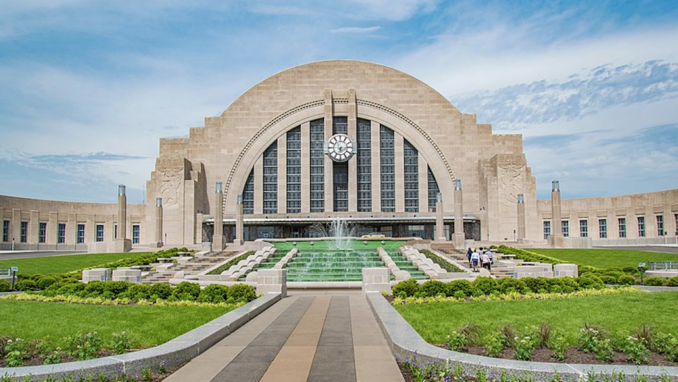
Cincinnati Museum Center.,
Ɱ – Licence CC BY-SA 4.0
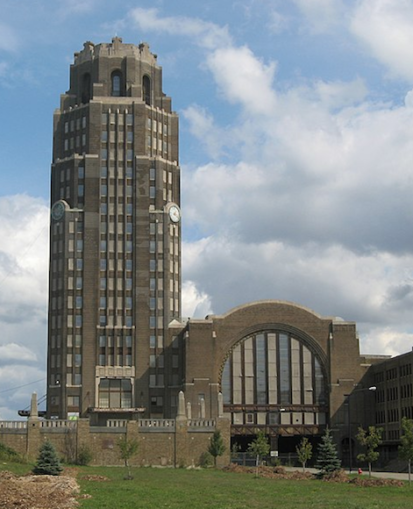
Buffalo Central Terminal Train Station,
Amathner – Licence CC BY-SA 3.0
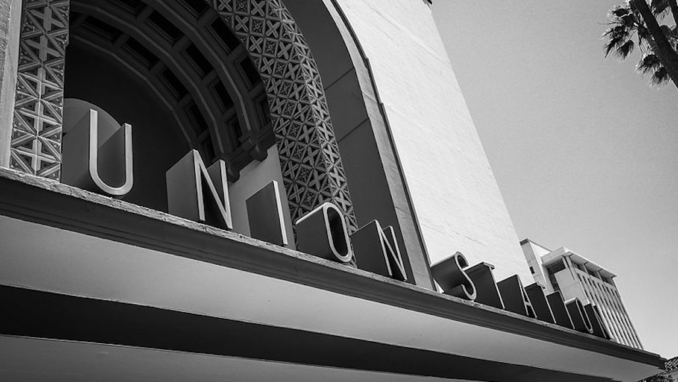
Details of Los Angeles Union Station,
Visitor7 – Licence CC BY-SA 3.0
Although the textbooks may disagree, I’ll add Los Angeles Union (1939, above) noting the big arch and lettering while turning a blind eye to the overwhelming impression the other 95% of the building gives of Spanish mission revivalism.
In the modern-day, Helsinki Central has similar lettering above its south entrance canopy although it spells out ‘Rautatifasema Järnvägsstation’ which means ‘railway station’ in Finnish and Swedish. Note – not train station. Here and elsewhere, there is always a railway between the platforms but not always a train. I’ll also throw in Milano Centrale (1931), evidence below.
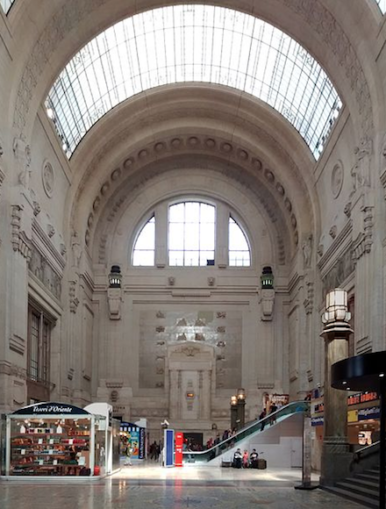
Milano Centrale railway station, entrance hall,
Gunnar Klack – Licence CC BY-SA 4.0
Having inferred Saarinen a genius of foresight we must analyse the influences upon him.
On either side of Helsinki Central’s arch stand two pairs of statues, part column and part Art Deco figures holding illuminated globes. Beyond acknowledging a nationalist romanticist influence, wiki and Beauty of Transport must be placed to one side. We shall lock Brian Sewell in the closet and are obliged to gag and bind Jonathan Meads while saying what we see.
Elsewhere, Art Deco bringers of light were ecstatic lithe female forms giving luminance from the mantelpiece of a Bermondsey townhouse towards the general direction of a child’s piano lesson. They were never white black people in rainbow coloured wheelchairs alighting from a dingy.
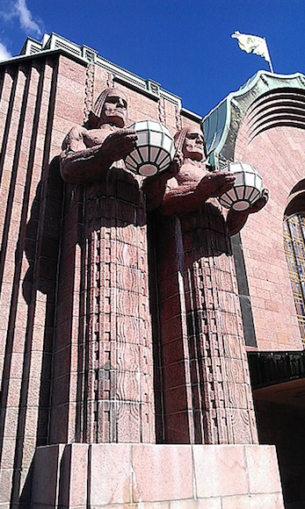
The statues at Helsinki Central railway station,
Ethan Doyle White – Licence CC BY-SA 2.0
Neither are Saarinen’s monumental designs. The human representations are those of the super-man, the idealised human form born of material plenty. Here, the light is represented by world-like orbs held firmly and comfortably between strong palms. Emotionless granite faces remind of Nietzsche’s quote of his and his contemporaries view of the perfect man who,
“falls if he allows himself to be dominated by feelings of pity, regret, and sympathy.”
This Art Deco stamps on what Marxism condemned as a “former table of values” where pity had been a virtue. Late 19th century amoral mechanical Darwinism saw pity as a failing. As Trotsky wrote in his summary of Zarathustra,
“The most horrible of misfortunes, is pity. If he feels anything for the unfortunate, if he is touched at the sight of sorrow, his destiny has come to an end: he is vanquished, his name must be crossed from the list of the caste of “masters.”
Gone is the naturalistic symmetry of Aristotelian perfection, replaced by the pitiless set square angles of the machine age. Even the orb is constructed of straight-edged pieces. Enlightenment no longer un-binds silk allowing muses to whisper to a bourgeois’ innocent ear, but shouts to the proletariate of production, ownership, control, distribution, economies of scale, mass production, not least from a giant new railway station in the middle of the capital of a new country (Finland became independent of Russia in December 1917).
After Nietzsche declared God dead his world concluded there was nothing left to satisfy other than the physical. But Nietzsche, Marx and the evolutionists did not kill God, they repressed worship of Him. The sensual and spiritual does not cease to exist because of the dominance of the material, it effortlessly finds another outlet.
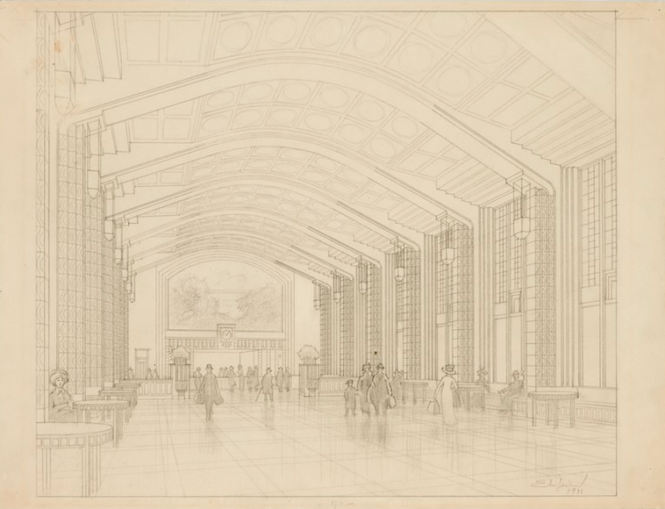
Helsingin rautatieasema, perspektiivipiirustus sivuhallista, 1911,
Eliel Saarinen – Licence CC BY-SA 4.0
Stepping through Helsinki Central’s entrance arch, the interior revealed is plain and functional but, all the same, has subsequently been bussied to a fetishist’s dream. Dispensing with the materialists, we must page Drs Freud and Jung. There is ratttleboard porn, 1:10 scale working steam erotica and double-decker sensuality.
What there wasn’t, until 2000, was a trainshed roof over the platforms. Originally Central mirrored its non-identical twin sister at the eastern end of the line in Leningrad, confusingly called Finland Station after the Russian style of naming stations after their destinations rather than where they’re at.
Arriving in the present day, as elites continue to foist their view of humanity upon the rest of us, those four statues guarding the Keskuskatu entrance have been wearing masks and holding globes disguised as Wendyballs.
Happy New Year!
Acknowledgements and Further Reading
The Beauty of Transport, The Men From The Future.
Leon Trotsky, On the Philosophy of the Superman.
Footnote
[1] A friend lived in Budapest during the Cold War and worshipped at the Inner City Church, a Sunday morning stroll along the banks of the Danube from the then threadbare Central Market Hall. Thinking he was fitting in, and accompanied by the organ Liszt composed on, he blasted out the hymns in the local lingo as best he could. Admonished for both his volume, lack of tune and pronunciation, he replied, “It’s all in Finno-Ugric which is difficult for the Anglo-Saxon tongue to pronounce.” Torn to shreds by all and sundry, in the ensuing melee he learned the true depth of pejorative that churchy types in 1980s Pest (in the interest of comradely equality) attached to the phrase ‘country people’.
© AlwaysWorthSaying 2022
The Goodnight Vienna Audio file



